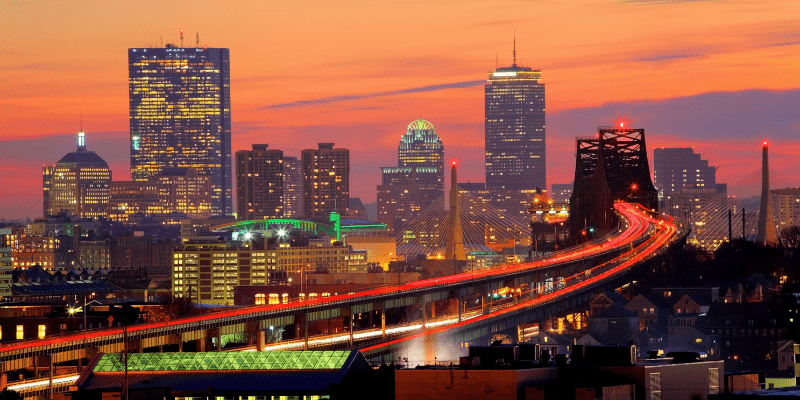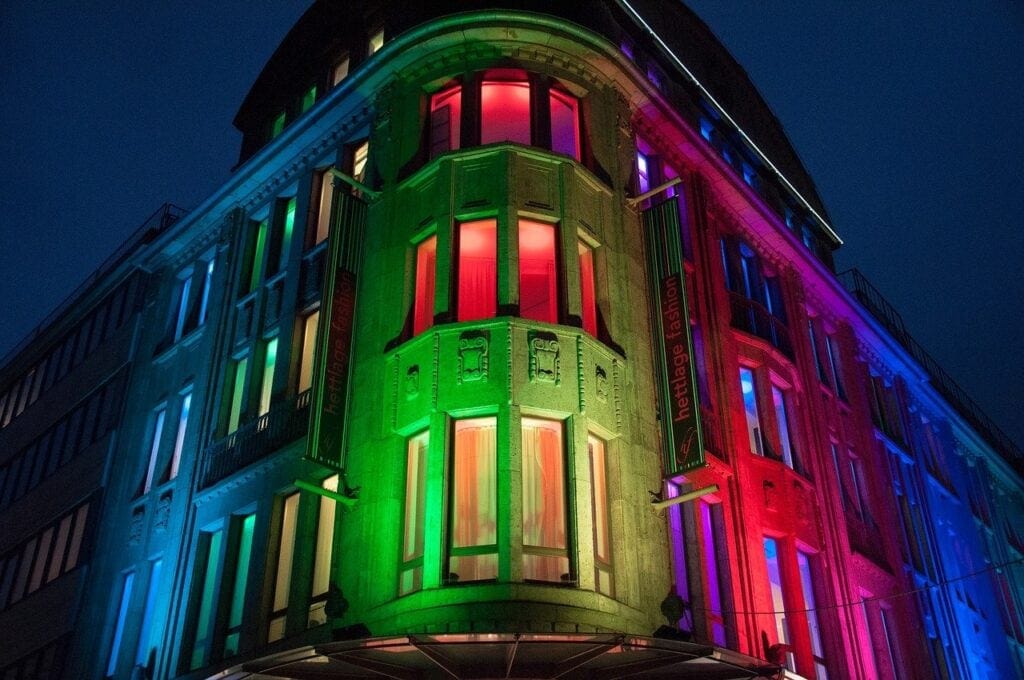But how can you achieve the perfect balance? Fret not! Here I have discussed the basics and the best architectural lighting practices based on evidence. Let’s get started.
What Is Architectural Lighting?
Architectural lighting is an approach to illuminating any architecture in such a way that it enhances its appeal, mood, and functionality. It can be indoor and outdoor illumination of space.

Lightning designers achieve this by exploiting certain building features using different types of lighting fixtures, colors, textures, and computational-based design tools.
The science of architectural lighting we know today is pioneered by Richard Kelly (1910-1977), an American lighting designer. He presented the famous three tenets of lighting, which dictate lightning practices today. These tenets explain how architectural lighting can manipulate the space and emotions of people to increase architectural appeal.
Visual aesthetics are just one part of architectural lighting. You have to consider the system’s functionality, efficiency, and sustainability.
Architectural lighting uses contemporary LED technology to refer to natural light (sunlight) and night lights (artificial lighting). In this article, our primary focus will be on the latter one.
What Are The Types Of Architectural Lighting?
Architectural lighting design has the following categories.
Facade lighting
Facade lighting is the basic luminaire for lighting building fronts. Each building’s front is illuminated to bring unique characters to it at night. LED technology played a pivotal role in such lighting.

Designers use linear facade lighting to target certain architectural features of a building, like doors, windows, domes, etc.
Floodlighting
Floodlighting is the oldest approach to illuminating architecture. It’s done by a high-powered lighting fixture placed at the bottom, which throws the light upward.
Floodlighting creates unique shadows and contrasts that instantly increase the appeal of any structure.
There are many types of floodlights. You’ll commonly see them in stadiums, bridges, warehouses, historical buildings, etc. This artificial light system is highly functional and aesthetically pleasing. A variation of it called spotlight is also used to highlight small areas and features of a building.

Task lighting
Task lights illuminate a certain area to increase the efficiency of certain tasks while maintaining aesthetics and glamor. It’s used in outdoor swimming pools, lawns, and parking lots.
However, indoors the task lighting is a cornerstone of any perfect lighting. For example, kitchen task lights can improve the cooking and dining experience. Similarly, it can draw attention to sophisticated paintings in an art gallery.
Ambient lighting
Ambient lighting targets the ambiance of any place. It’s concerned with the overall space’s mood, aura, and vibe.
Moreover, it’s a bit more subjective approach to lighting. Designers use different colors, textures, temperatures, and brightness to control the environment and enhance the appeal. Ambient lighting uses recessed lights, LED strips, track lights, spotlights, etc.

Indirect Lighting
Indirect lighting is a sub-category of ambient lighting, bringing much more elegance to the table. Such lights are concealed in valances and coves. Usually, a continuous strip of light is hidden in the ceiling, which lights up the ceiling and indirectly reflects over an area.
Benefits of LED Architectural Lighting
Lighting the place can be effectively done by installing a few well-spaced luminaires. But it takes a certain skill to take it up a notch and make a difference. The science of architectural engineering does just that.
Fewer Limitations
Architectural engineering has been continuously evolving for the past 80 years. Traditionally, the primary light sources were fluorescent, halogen, and halide lights. But since the advent of LED lights, designers have more room to control visual perception, space, and the illumination of an area.
LEDs provide high color rendering index CRI which can draw out the object’s actual color. The lighting fixtures are also available in numerous forms, such as LED strips, recessed, spot, and linear lights.
LEDs also come with programmable color types and temperatures, which gives you a vast area to play with. Many hotel and restaurant owners use this to create a dynamic lighting set-up, which adds elegance to a place.
Increase Safety and Functionality
What separates an artist from a designer is the purpose of the work. Sure light’s primary purpose is to illuminate the place and be aesthetically pleasing. But architectural lighting takes it a step further and introduces functionality.

Consider a staircase illuminated by modern lights enriching the overall environment but not enough light for safe movement. That’s a poor design approach.
LED lights make sure the functionality of a place is not compromised while maintaining the aesthetics of the place. Essentially killing two birds with one stone.
Environment Friendly
Experts suggest that architectural lighting has grown significantly, and more emphasis is now on energy sustainability and light pollution.
Mismanagement and poor calculations result in unnecessary light pollution in the sky, which creates all sorts of problems.
Low-quality light temperature can also disturb circadian rhythms, negatively affecting the person’s mood. However, LED lighting manages the problems and creates healthy and safe architectural lighting.
Common Applications Of Architectural Lighting Systems
Highlighting the Feature
Architectural lighting is mainly used to exploit the design features of any building. In the modern era, cove lighting and accent lighting are primarily used. You might have seen it in malls, buildings, art galleries, hotels, etc.
A design feature can include outdoor windows, domes, indoor horizontal borders, vertical borders, staircases, kitchen islands, etc. It provides a story of a building people can’t see but can feel.
Energy Efficiency and Practicality
Architectural lighting is not purely subjective. It also concerns energy consumption, light output, power density, and visibility. Some credible societies, such as ANSI and the International Commission on Illumination (CIE), govern these criteria.
Luminance is the technical term that quantifies the brightness of the space over an area of a one-meter square. Its unit is candela per square meter (cd/m^2).
Another important term in architectural lighting is Luminous Flux or Power. It’s a perceived light and not the actual light produced by the source. Lumen flux is measured in Lumens (cd. sr). You’ll often see its value on the cover of the light bulbs.
This table shows how designers quantify and select the luminaire based on standardized quantitative data.
|
Requirement of Average Luminance of Flood Lighting |
|
|
Zones |
Average Luminance Lavg (cd/m^2) |
|
Rural areas |
4 |
|
Small urban cities, suburbs, and towns. |
6 |
|
Commercial and Recreational areas |
12 |
Advertisement
Another popular application of modern architectural lighting is running advertisements. Companies run ads using interactive media LEDs, which engage the audience in real-time. It captivates the people and draws them towards the building.
How To Choose Architectural Lighting For Your Needs?
Exterior lighting
If you plan to light up the exterior of any building, the requirement of the lighting fixtures is different. You are mostly going to use floodlights, facade lights, and spotlights.
Moreover, you may choose between two fundamental methods of lighting, i.e., the “Planer Method” and “Accent Method.”
The former involves more uniform distribution, while the latter highlights specific architectural features. Each style depicts a different story, aesthetics, and function.
Lighting Borders and Features
When it comes to indoor lighting architecture, it’s pivotal to showcase the design features of walls, floors, and ceilings. You can choose cove, recessed, and wall washers to achieve that. Indirect lighting is a safe bet when you don’t want extreme dazzle but still like to maintain elegance.
Wall washing and grazing are popular methods to highlight textures in the walls. Similarly, track lights can enhance the functionality of a place like a kitchen and a hall.
Specialized Places
Architectural lighting in commercial places like stadiums, theatres, and cinemas improves the place’s visuals and practicality.
Linear LED lights on the floor in cinemas provide directions and a character to the place. In addition, many pools have underwater LED lights that give them a unique appearance.
Immersing Nature
Maybe you can utilize natural aspects while designing lighting for your building, such as mist, sunlight, and water bed. By reflecting and diffusing light through natural elements, you can create a unique surreal character of the building.
As you can see from the above example of natural lighting, an artificial haze machine and monochromatic light give a unique ambiance to the place.
Tips For Installing And Using Architectural Lighting Fixtures Effectively
Inspiration
Your project needs inspiration. This will help you achieve your goal much faster. Inspiration could be anything from your favorite building to a well-renowned painting. Just imitate that aura, and you’ll get a masterpiece.
Cost Effectiveness
Remember, architectural lighting is supposed to be continually running throughout the night. So it would be best if you had high-quality LED luminaires that consume less energy. However, you have to mind the operational cost as well. You can achieve perfect architectural lighting by balancing the cost with aesthetics.
Consult a Lighting Designer
There is no replacement for an expert. A lighting design engineer can analyze the space and environment and give the best solutions possible. They are also well-versed in modern trends and know the city regulations on lighting fixtures.
A lighting designer uses a different design process than an electrical engineer or interior designer. They are experts in making functional aesthetic visuals and exploiting the feature of architecture in the best possible way.
Final Thoughts
The lighting industry is continuously advancing, and newer, more efficient luminaires are flooding the market daily. Knowing the basics of architectural lighting will be a stepping stone to devising your lighting plan.
Most of the time, people are drawn to the lights rather than the actual features. So be sure to invest in high-quality products, as the lighting design is the brand of any architecture.
RC Lighting Brings You The Best Architectural Lighting Solution
We have already established that lighting directly affects the appeal of architecture. And how to design architectural lighting for your project.
What’s left is where to buy quality products that last long and deliver premium light. RC Lighting brings superior quality luminaires manufactured in state of a art facility.
We produce high-quality indoor and outdoor luminaires like flood lights, spotlights, facade lights, recessed lights, cove lights, and more.
RC Lighting also provides customized orders suitable to your project. You can also consult our experts via the 24/7 helpline.
So, what are you waiting for? Get in touch NOW!



